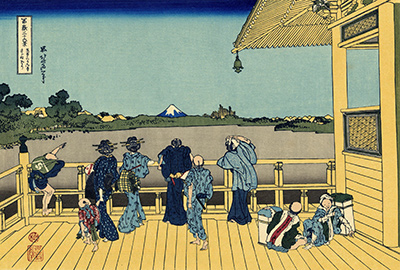Sazai Hall - Temple of Five Hundred Rakan is one of Hokusai's less famous works, and is so often the case with his art, may come as something of a surprise to Western viewers who are familiar only with The Great Wave off Kanagawa. It shows an idyllic scene, with five figures - men, women and children - standing upon a veranda outside a temple.
Before them lies a lake or marsh, spreading out to meet the horizon in the distance. The image is composed so that most of the nine figures are seen from the rear, as though the viewer is standing behind them, also observing the view. Mt Fuji, a recurring theme in Hokusai's work, can be seen in the distance; also identifiable to those familiar with Japanese geography are the lumber yards of Fukagawa. Hokusai's skill at portraying human subjects is as adept at his mastery of the natural world: the nine figures each have their own character, from the one on the left eagerly pointing in the direction of Mt Fuji, to the one towards the right mobbing sweat from his forehead.
The original Sazai Hall - Temple of Five Hundred Rakan is part of the collection at the British Museum, but with a print of the artwork, any art lover will be able to display this beautiful scene from a bygone Japan right in their very own home. Nobody who appreciates the rich and unique Japanese culture could pass up such an opportunity!
Mention Japanese art to someone in the West, and one name above all others is almost certain to come up in the discussion: Hokusai. Although he is best known for his 1832 print The Great Wave off Kanagawa, this is no more than the merest tip of the iceberg when it comes to Hokusai's substantial oeuvre. His body of work encompasses a wide range of different themes: landscapes, still lives, supernatural scenes from legend, erotic tableaux, and even humorous cartoon-like images. Throughout his career, Hokusai depicted eighteenth and nineteenth-century Japan as he saw it, using a style and technique rooted deep within the traditions of his culture.




